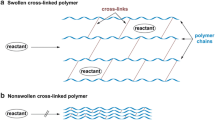Abstract
Di-tyrosine is one of the major protein cross-links involved in a large number of neurodegenerative or ageing-related diseases. Recently, no less than four different di-tyrosine bridge isomers have been highlighted while only two structures are characterized at the moment in the literature. In this study, the four dimers were produced by radiolytical-induced oxidation. Although the abundance of these additional dimers precluded the use of NMR or other structural characterization methods, we propose a new methodology combining UPLC-MS analysis, specific deuterium labelling and isotopic (H/D) exchanges with the solvent. Thus, we were able to identify three different covalent cross-links and propose different new original di-tyrosine structures based on double Michael additions, leading to tetracyclic products. Absorption and fluorescence characterizations of the four species were performed and consolidate our proposal.
Graphical abstract














Similar content being viewed by others
Abbreviations
- DOPA:
-
Dihydroxyphenylalanine
- FLD:
-
Fluorescence detection
- H/D:
-
Hydrogen/deuterium
- HOHICA:
-
3A-Hydroxy-6-oxo-2,3,3a,6,7,7a-hexa-hydro-1H-indole-2-carboxylic acids
- HPLC:
-
High-performance liquid chromatography
- MAD:
-
Michael addition dimer
- MS:
-
Mass spectrometry
- NMR:
-
Nuclear magnetic resonance
- NOE:
-
Nuclear Overhauser effect
- PDA:
-
Photo diode array detector
- UPLC:
-
Ultra high-performance liquid chromatography
References
Andersen SO. The cross-links in resilin identified as dityrosine and trityrosine. Biochim Biophys Acta BBA - Gen Subj. 1964;93:213–5.
Raven DJ, Earland C, Little M. Occurrence of dityrosine in Tussah silk fibroin and keratin. Biochim Biophys Acta BBA - Protein Struct. 1971;251:96–9.
Aeschbach R, Amadoò R, Neukom H. Formation of dityrosine cross-links in proteins by oxidation of tyrosine residues. Biochim Biophys Acta BBA - Protein Struct. 1976;439:292–301.
Boguta G, Dancewicz AM. Radiation-induced dimerization of tyrosine and glycyltyrosine in aqueous solutions. Int J Radiat Biol Relat Stud Phys Chem Med Taylor & Francis. 1981;39:163–74.
Giulivi C, Traaseth NJ, Davies KJA. Tyrosine oxidation products: analysis and biological relevance. Amino Acids. 2003;25:227–32.
van der Vliet A, O’Neill CA, Halliwell B, Cross CE, Kaur H. Aromatic hydroxylation and nitration of phenylalanine and tyrosine by peroxynitrite: evidence for hydroxyl radical production from peroxynitrite. FEBS Lett. 1994;339:89–92.
Karam LR, Dizdaroglu M, Simic MG. OH radical-induced products of tyrosine peptides. Int J Radiat Biol Relat Stud Phys Chem Med Taylor & Francis. 1984;46:715–24.
Jacob JS, Cistola DP, Hsu FF, Muzaffar S, Mueller DM, Hazen SL, et al. Human phagocytes employ the myeloperoxidase-hydrogen peroxide system to synthesize dityrosine, trityrosine, pulcherosine, and isodityrosine by a tyrosyl radical-dependent pathway. J Biol Chem. 1996;271:19950–6.
Hensley K, Maidt ML, Yu Z, Sang H, Markesbery WR, Floyd RA. Electrochemical analysis of protein nitrotyrosine and dityrosine in the Alzheimer brain indicates region-specific accumulation. J Neurosci Society for Neuroscience. 1998;18:8126–32.
Atwood CS, Perry G, Zeng H, Kato Y, Jones WD, Ling K-Q, et al. Copper mediates dityrosine cross-linking of Alzheimer’s amyloid-β †. Biochemistry. 2004;43:560–8.
Gatin A, Billault I, Duchambon P, Van der Rest G, Sicard-Roselli C. Oxidative radicals (HO• or N3•) induce several di-tyrosine bridge isomers at the protein scale. Free Radic Biol Med. 2021;162:461–70.
Getoff N. Pulse radiolysis of aromatic amino acids - state of the art. Amino Acids. 1992;2:195–214.
Gmeiner B, Seelos C. Phosphorylation of tyrosine prevents dityrosine formation in vitro. FEBS Lett. 1989;255:395–7.
Gmeiner BMK, Seelos CCC. Tyrosine phosphorylation blocks tyrosine free radical formation and hence, the hormonogenic iodination reaction. Free Radic Biol Med. 1996;21:349–51.
Möller MN, Hatch DM, Kim H-YH, Porter NA. Superoxide reaction with tyrosyl radicals generates para -hydroperoxy and para -hydroxy derivatives of tyrosine. J Am Chem Soc. 2012;134:16773–80.
Jin F, Leitich J, von Sonntag C. The superoxide radical reacts with tyrosine-derived phenoxyl radicals by addition rather than by electron transfer. J Chem Soc Perkin Trans. 1993;2:1583.
Winterbourn CC, Parsons-Mair HN, Gebicki S, Gebicki JM, Davies MJ. Requirements for superoxide-dependent tyrosine hydroperoxide formation in peptides. Biochem J. 2004;381:241–8.
Das AB, Nauser T, Koppenol WH, Kettle AJ, Winterbourn CC, Nagy P. Rapid reaction of superoxide with insulin-tyrosyl radicals to generate a hydroperoxide with subsequent glutathione addition. Free Radic Biol Med. 2014;70:86–95.
Resch V, Seidler C, Chen B-S, Degeling I, Hanefeld U. On the Michael addition of water to α, β-unsaturated ketones using amino acids. Eur J Org Chem. 2013;2013:7697–704.
de Figueiredo RM, Christmann M. Organocatalytic synthesis of drugs and bioactive natural products. Eur J Org Chem. 2007;2007:2575–600.
Nising CF, Bräse S. The oxa-Michael reaction: from recent developments to applications in natural product synthesis. Chem Soc Rev. 2008;37:1218.
Rupprecht KM, Boger J, Hoogsteen K, Nachbar RB, Springer JP. Controlling the stereochemistry of the ring junction in hexahydrodibenzofurans. J Org Chem. 1991;56:6180–8.
Funding
This research did not receive any direct specific grant from funding agencies in the public, commercial or not-for-profit sectors. Access to the UPLC-MS was funded as the MOBICS project funded by a DIM Analytics programme from the Ile-de-France region.
Author information
Authors and Affiliations
Contributions
Experiments were performed by I. Billault, A. Gatin and C. Sicard-Roselli. The manuscript was written by I. Billault, A. Gatin C. Sicard-Roselli and G. Van der Rest.
Corresponding author
Ethics declarations
Conflict of interest
The authors declare no competing interests.
Additional information
Publisher's note
Springer Nature remains neutral with regard to jurisdictional claims in published maps and institutional affiliations.
Rights and permissions
About this article
Cite this article
Billault, I., Gatin, A., Van der Rest, G. et al. Advanced methodology combining UPLC-MS, isotopic labelling and H/D exchanges reveals three tyrosine-tyrosine cross-links induced by oxidative radicals evolving to at least four dimeric structures. Anal Bioanal Chem 414, 1595–1607 (2022). https://doi.org/10.1007/s00216-021-03782-x
Received:
Revised:
Accepted:
Published:
Issue Date:
DOI: https://doi.org/10.1007/s00216-021-03782-x




